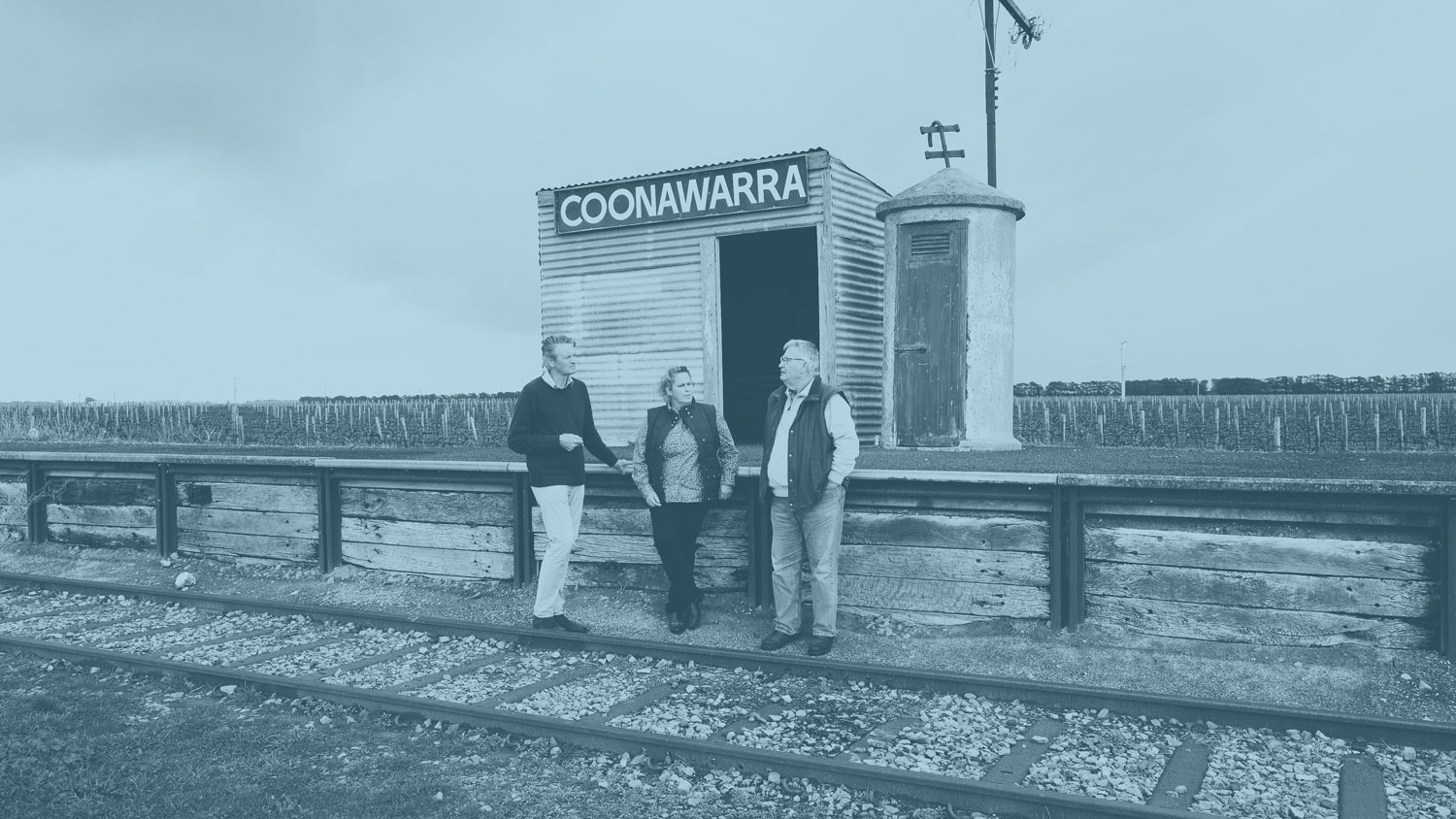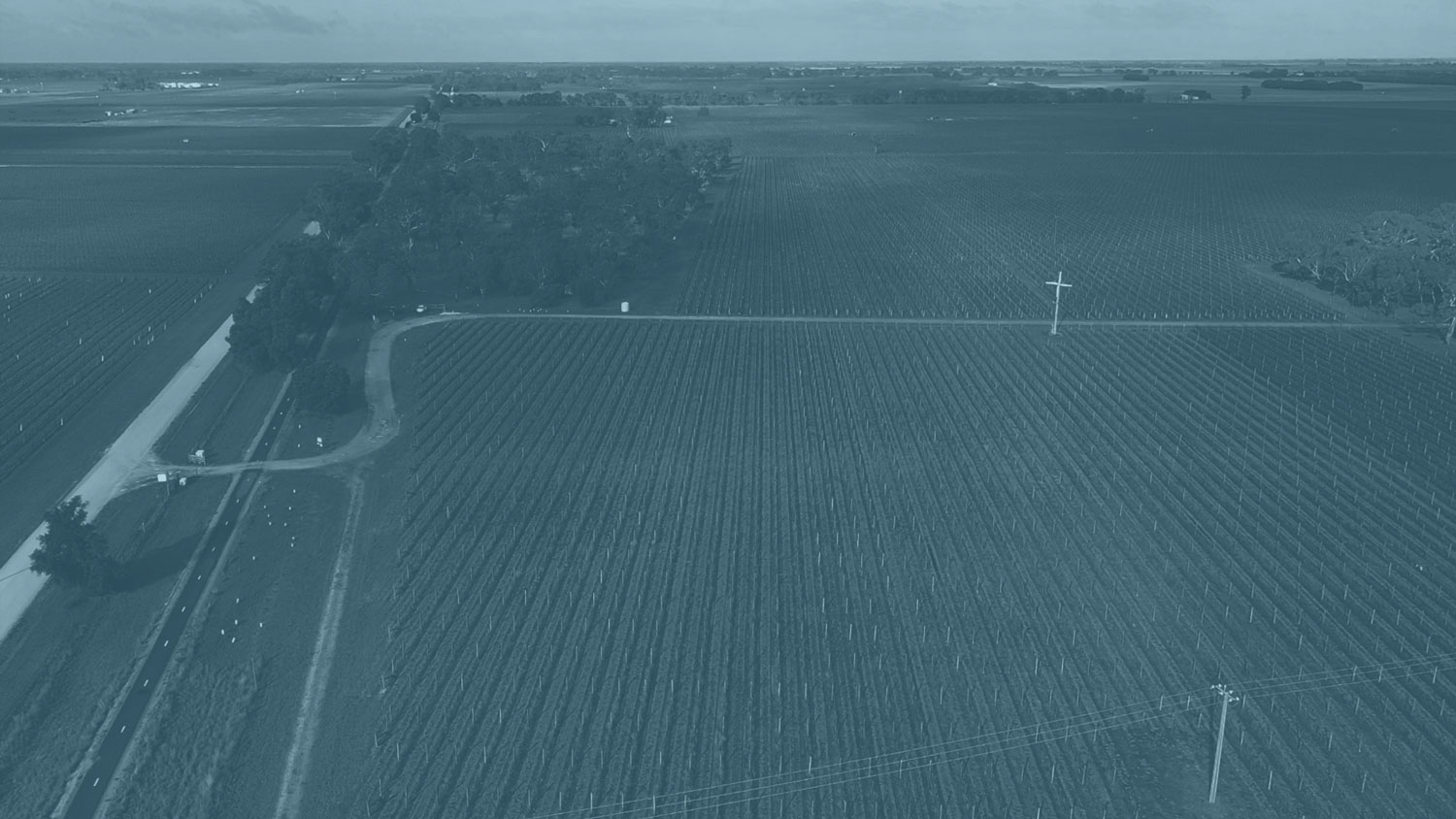Our
Story

Want to know more about us and our history? Read below. Yes, we are aware there is alot to read.
Our narrative is rather unconventional, we never aspired to be winemakers and were content as grape growers. However, unforeseen circumstances dramatically shifted our course. GWB Wine Estates emerged from an industry in turmoil, and we realised that without significant change, our future looked bleak. Having owned vineyards and sold grapes in Coonawarra for over two decades, we found it challenging to establish a stable enterprise with supportive wine brands. Despite 60 hectares of our vineyards being situated on the sought-after eastern side of the Coonawarra railway line, we were informed that our primary 120-hectare vineyard, located just 400 metres south of the renowned Coonawarra rail siding, was less desirable, because it was situated on the western side of the railway line. For the initial dozen or so years, all our fruit was sold to Katnook Estate. However, as Katnook changed hands, our contracts concluded.
Before the Chinese tariffs on Australian wine exports were imposed, many bulk winemakers were eager to blend Coonawarra fruit with grapes from other regions. The years 2019 and 2020 were our most prosperous. In 2020, a total of 11 groups purchased grapes from us; by 2021, with the tariffs in effect, only three remained. A contingency plan was urgently needed. Below, we outline the steps we’ve taken to sustain our business and, more importantly, the land we steward.
In late 2020 crippling tariffs were put on bottled Australian wine by China. Our pivot of the business began immediately. We would build a wine brand. It would not save our business in the short-term but potentially would in the medium term. We needed a winemaker! We were not sure where to start, but our Viticulturist Rae Clark suggested, we ask Peter Douglas. Peter had bought 20 tons of fruit from us for many years, making wine for others. Jack didn’t know Peter, so Rae popped the question! Peter was keen to chat further.
Jack called Peter, somewhat nervously given his reputation for being one of Coonawarra’s greatest winemakers. The pitch was simple, our business was in trouble, would Peter become our partner in a new venture and take Coonawarra back to where it was in the 1980/90’s when he was the head winemaker at Wynns. Yes, was his answer. But what he then said gave us hope ‘’ you have very good vineyards! In fact, Cabernet I have made with your fruit has had success at major Australian wine shows and some of your best retails for over $300 per bottle! I must say we were stunned.
With that conversation, the company GWB Wine Estates was formed with Rae, Peter and Jack as shareholders. Our goal with GWB Wine Estates is undoubtedly different to most of our peers. Strangely it is similar to how Katnook Estate began its life about 40 plus years ago. A glut of grapes led Katnook, who had been a significant grape grower, to begin making wine with a small portion of their best grapes.
Our vision was also honed by a fantastic article, written in 2008, by Kevin Kelly, titled ‘’1,000 True Fans’’ We only want to use the best 2% of our grapes which would help us build a roughly 3,000 case wine business. It would allow us to showcase the work Rae does in the vineyards and Peter’s genius, but more importantly prove the other 98% of our fruit we produce was quality worth buying.
In 1,000 True Fans, Kevin Kelly notes ‘’to be a successful creator you don’t need millions. You don’t need millions of dollars or millions of customers, millions of clients or millions of fans. To make a living you need only thousands of true fans. A true fan is defined as a fan that will buy anything you produce. If you have roughly a thousand true fans, you can make a living – if you are content to make a living but not a fortune. The number 1,000 is not absolute. Its significance is in its rough order of magnitude’’
It dawned on us, after reading what Kevin thoughtfully wrote, that being big for the sake of being big was pointless. We are grape growers and want to continue to be grape growers. A small and good quality wine brand seems to be a sensible way to think about our business. We hope it resonates with people and we can find our True Fans.
Our
Vineyards
Vineyards are often overlooked, with many large brands serving as mere amalgamations of grapes, striving for a premium character through overripe fruit and excessive oak, with no mention of the vineyards themselves, only the region. We view our vineyards through a different lens. With Peter’s discerning palate, one realises that a mere 20 steps to the left or right within a vineyard can dramatically alter the taste and style of the wine.
We hope one day our vineyards can in a small way resemble what Andy Beckstoffer has built in the Napa Valley with his large vineyard holding. From Youtube interviews, the Beckstoffer vineyards sell to 137 wine makers. They have focused on finding the best winemakers so their fruit can be seen at its best in a bottle. They also have a pricing model so the more a brand sells for the more they are paid for fruit. They work on a set % of fruit payment being equal to about 25% of what the winemaker sells the bottle for. By getting paid properly they can re-invest in the vineyards and grow better fruit.
Our 4 vineyards have 3 locations.
MacVale
MacVale was acquired as an undeveloped block in 2001, this 42-hectare vineyard was planted under the supervision of Coonawarra legend Wayne Stehbens. Situated on Lynch's Road on the eastern side of the railway line, the vineyard is a kilometre northwest of the Coonawarra township as the crow flies.
The well-drained soils range from dark chocolate clay loam to red, with varying depths of 30-50 cm over limestone. We have planted four varieties: 21 hectares of Cabernet Sauvignon, 9 hectares of Chardonnay, Shiraz 8 hectares and Merlot 4 hectares. In 2023 we are adding 3.5 hectares to the Chardonnay component with a corresponding reduction of Shiraz. We are planting more of the Mendoza clone plus some Bernard 76/95 clones. The Chardonnay originally planted, was typical Wayne Stehbens, who liked to experiment, and as a winemaker wanted to use the Mendoza clone which few others had in the region.
For the first 10 years of production all the fruit was purchased by Katnook Estate. In 2023 a total of 7 different single vineyard Chardonnay wines have been made from MacVale. The vineyard is currently in transition to organic, with 2025 our first certified organic harvest.
Oborn
Oborn was purchased in 2004. It has 18 hectares of Cabernet Sauvignon mostly planted by Katnook viticulturist Leon Oborn in 1997/98. The vineyard was leased to Katnook Estate until about 2015 and the fruit was used for Katnook Estate Cabernet Sauvignon. The vineyard is 2km northeast of Penola. It is bordered on the eastern side by Penola racecourse and the western side Bowen Estate and Balnaves vineyards. The soil varies from a shallow sandy loam over red/brown clay over limestone to reddish-brown loam over limestone on the ridges.
The vineyard is currently in transition to organic, with 2025 our first certified organic harvest.
Richings 1 & 2
Richings 1 and 2. Both vineyards cover 60 hectares and were planted by Katnook Estate from the early 1990s. Located on the western side of the railway line, these vineyards feature soils that vary from dark chocolate clay loam to red clay loams over limestone. The soils are free-draining and have varying depths of 30-50 cm over limestone.
Richings 1 was purchased in 2011. It is planted with Cabernet Sauvignon, Merlot, Shiraz and Sauvignon Blanc. 47 hectares of the vineyard is currently in transition to organic, with 2026 our first certified organic harvest.
Richings 2 was purchased in 2015. It turned out to be a very difficult purchase for the first 4 years but we recently discovered ‘’every cloud has a silver lining’’ Operationally it made sense for us to purchase this vineyard as it shared a bore with Richings 1, however finances were tight. With a change in ownership its fruit contracts became null and void. The buyer of the fruit gave us a handshake agreement that when ownership changed, they would re-contract the fruit. Unfortunately, once we settled, the fruit buyer told us, that because the ownership had changed the contract was null and void. It was a difficult first 4 years of ownership.
From 2021 things began to change. As Peter had access to our best fruit for our own label, he found a ‘’special little spot’’ in Richings 2 that he takes our best Cabernet Sauvignon from. The silver lining continues because in 2022 we made some Shiraz from Richings 2. In our tastings it stood out as simply our best 2022 wine. In 2023 Peter again took the best Shiraz from a section of the vineyard on a small red ridge. Peter was again very happy with the quality of the fruit. Asked why is it so good and the silver lining suddenly appeared again. ‘’ A parcel of fruit from there was used by Wayne Stehbens in the blend that made the 1997 Katnook Prodigy that won the 1998 Jimmy Watson trophy’’
It seems the fateful decision in 2015 to purchase this block might well pay dividends.
There is a significant red ridge on the south eastern part of the block where the Shiraz is located. The vineyard is planted with Cabernet Sauvignon, Merlot and Shiraz. 43 hectares of the vineyard is currently in transition to organic, with 2026 our first certified organic harvest.


Sustainability
Approach
We are proud to acknowledge and share with you our focus on sustainable approach when we make and sell our wine.
Our commitment to sustainability and organic practices emerged rather serendipitously. In 2015, we confronted a vineyard that was, in plain terms, ailing. The vines lacked vitality, uniformity, and produced subpar yields. Recognising the need for a radical shift, we experimented with an organic microbial additive on both the soil and vines. This live formula, comprised of beneficial bacteria naturally found in the soil, thrives in warm, moist conditions. Unlike many agricultural additives that aim to eliminate harmful elements, this microbial additive, nurtures the soil’s ecosystem. The results were astonishing; over the last eight years, the vineyard has yielded an average of 59% more fruit compared to the preceding eight years. This vineyard now produces some of our most premium fruit and is on track to achieve organic certification by 2025.
Rae, our viticulturist, was invigorated by these results. She began to phase out chemicals from our vineyard management, advocating for a more sustainable approach. We incorporated Tea concoctions based on seaweed, some of which Rae crafted herself from seaweed gathered from Wright Bay, located 130 km away.
We found our microbial was giving us far more root vigour and capturing more nutrients to feed into our vines. Rae found a small business that did soil tests and told us we were missing certain elements, so in our Tea, we added those. With every year we kept getting healthier soil, healthier vines, healthier fruit. 2020 was the litmus test. The year produced a very low crop across Coonawarra (26,200 tons) versus the normal 35/40,000 tons. We were on par with our long-term average for Cabernet. Something was working.
All the vineyards have been Biologically managed since 2018. In 2018 we became members of Sustainable Wine Growers Australia. We joined in with South Australia’s Eco Grower program in 2020 and as part of this project we have planted over 900 trees, grasses and shrubs creating a safe habitat for our native wildlife to thrive including insects, frogs, bats and birds. Collaboratively these all help to create balance in our vineyard environment and significantly reduce the need for hazardous chemicals in our vineyards.
However, more was to happen. In September 2022 Rae said that we had been ‘’organic’’ for nearly a year. Rae had taken all chemicals/pesticides out of our process. We laughed and simultaneously said, ‘’maybe we should go organic?’’ An audit was arranged and across 60ha of our vines we are organic in transition, with organic certification hopefully by November 2024. Another 90ha will hopefully achieve organic certification in November 2025.
December 2022 saw the addition of our own beehives. We have 3 different colonies that we have located across the 3 different vineyards. We plan to give honey away to our True Fans or sell it to support local charity groups.
Our approach to sustainability/organic is not a marketing gimmick. When we started to focus on this, it was to help fix a sick vineyard. We did not have a brand and never thought we would. To us it was just a better way of doing things that resulted in a win/win scenario.
What's in
a name
As we began the journey to build a brand, we sought advice from a couple of friends who were both successful in the Advertising world.
As we embarked on the journey to establish a brand, we consulted with a few friends who had achieved considerable success in the advertising industry. Their counsel was straightforward: even with a high-quality product, penetrating a fiercely competitive market would be challenging. The retail landscape in Australia is increasingly dominated by a handful of companies that own a majority of the brands on the shelves.
Their advice led us to ponder the significance of a name in such a competitive environment. A name is not merely a label; it encapsulates the essence and ethos of a brand. It serves as a beacon that attracts those who resonate with what the brand represents. Therefore, we took great care in selecting a name that would not only stand out but also encapsulate our values, history, and aspirations.
They gave us articles to read about the competitive market we were embarking into, real numbers showing ‘’own brands’’ were far more profitable for big retailers and also a great article titled ‘’1000 True fans’’ by Kevin Kelly, which has been referenced in our background information.
With their advice we went to work on our new brands.
GWB WINES ESTATES
George W Burston was Jack’s Great grandfather. He and his brother James ran the successful Burston Malting business in Melbourne. James was the serious type, who ran the business, became Melbourne Lord Mayor and commanded the 7TH Infantry to Gallipoli in June, 1915. George on the other hand retired from the business at young age, was a founding member of the Melbourne Bicycle Club, later becoming President and was known as a larrikin. The rage in Melbourne in the 1880/90’s was the High-Wheeler or Penny Farthing bikes. This was George’s great passion along with his friends the Stokes boys.
As President of the Melbourne Bicycle Club, George presided over the running of the Austral bicycle event, held for many years on the MCG with crowds of up to 60,000 people. In addition to that, George was a keen cyclist at one stage holding the Australian 100 mile record, in 1888 attempting to ride his Penny Farthing, along with Harry Stokes, around the world and in 1894 being the first to ride up and down Mount Hotham. Given it was a dirt track and the bicycle had no brakes or gears, it was a decent effort. GWB Wine Estates seemed a good company name to use.
HIGH WHEELER
In 1888 ‘’mates George Burston and Harry Stokes embarked on a pleasure trip round about the world visiting exotic destinations on penny-farthings’’ Penny Farthings, were also known as High Wheelers.
Of George’s cycling feats, perhaps the greatest was the ride up and down Mt Hotham in 1894. If George could achieve that, we could start a wine company. The labels use an old black and white photo taken before the epic round the world attempt, with the jackets coloured in fabrics from countries George and Harry cycled through.
High Wheeler dips the hat to George and his bicycle adventures.
OVER THE LINE
Coonawarra is split diagonally in half by a railway line that ran from Mount Gambier to Adelaide. In 1898 the famous Coonawarra rail siding was built by John Riddoch to transport wine and produce from the newly formed Coonawarra Fruit Colony.
As a buyer of grapes for his own use, we had always offered Peter fruit from the Richings vineyards. We had always been told by big wine companies that Richings was on the wrong side of the rail line. Hence our brief to Peter, in March 2021, was simple, east or west of the line, across our 180ha, simply find the best fruit. We fully expected Richings would not get a look in.
What happened next was a bit of a shock. Peter told us our best fruit was from the wrong side of the rail line, the western side. His reasoning was simple. Peter chose his fruit not based on soil colour but based on fruit taste. He found that the fruit on the western side of Coonawarra where there was less red soil and darker (brown/black) soil tended to sit on a clay base. Fruit on a clay base in his view had softer tannins than the fruit from the eastern side with red soil that sat on a sandy base. Our best fruit was from the wrong side of the tracks.
We were stunned. Peter also noted that historically going back many years the western side of Coonawarra was too wet to ripen fruit. In wet years water would bubble out of the bores. In wet years now, our bores may have water 6-10m from the surface so it seems ‘’climate change” has impacted water levels and helped ripen our western fruit. In addition, the growth of the Forestry Industry in the region and hence better drainage, over the past 40 years, have dropped the water table. For one of the Regions best winemakers over 40 years to go against conventional wisdom was illuminating. For every grape buyer we traditionally dealt with, 9 out 10 told us, our western vineyards were rubbish!
With that came the name Over the Line. The label depicts a train ticket with the rail line splitting Coonawarra in half with a hole punch through it where the Richings vineyards are located. The long rectangular shape depicts the long thin stretch of land that is Coonawarra.
About
us
Rae Clark.
Viticulturist.
Where does one begin with Rae Clark? She is nothing short of extraordinary. Without her, this venture would not have come to fruition. Although she often remains in the background, her results speak volumes. In an industry where senior roles are predominantly occupied by men, Rae has proven that she needs to be even more exceptional to garner the respect she rightfully deserves. She has been a part of our team for over a decade and has managed the vineyards since 2018.
Rae and her team are constantly engaged in multiple trials within our vineyards, fine-tuning and experimenting with various approaches to enhance the health and efficiency of our vines and soil.
Jack Burston.
Coonawarra Fan.
Unabated fan of Coonawarra. Jack grew up in a farming family. In the 1980/90’s his love of good wine and Coonawarra took shape. For years he worked overseas and would serve his favourite wines from Katnook Estate, Bowen Estate and Wynns. Saturday night in Tokyo and it would be Napa v Bordeaux v Coonawarra. Little did he know one day he would be involved in growing grapes and making wines from this historic and famous region himself.
Peter Douglas.
WineMaker.
Peter has amassed four decades of winemaking experience since his graduation from Roseworthy College. He began his career with Wynns in Griffith. From 1985 to 1998 Peter was the head winemaker for Wynns in Coonawarra.
In 1990 he was responsible for the redevelopment of the Wynns Michael Shiraz.
During his time at Wynns they were brought into the Southcorp group of companies which increased his responsibilities to include the making of components of products such as Penfolds Grange, Bin 707 and Bin 389, Lindemans St George and Limestone Ridge along with many other super premium wines.
From 1999 onwards Peter made wine in the USA, Italy and Tunisia before moving back to Coonawarra where he has made wine for a number of companies.
Peter’s passion for the region and Cabernet in particular is something to behold. He is man who has made many amazing wines over the years and his comments below hopefully give you cause to try a bottle or two.
“I have lived and made wine in many nice places around the world but I have ended up back in Coonawarra because it is not only a great place to live but I now believe is the best place in the world for making the king of all wines Cabernet Sauvignon”.
‘’Over the Line and High Wheeler are my first gig where the wines are really what I want to drink and I trust most consumers are enjoying drinking. That is wines where the wine is made from my mind’s eye not with others looking over my shoulder’’
‘’Cabernet will make wine almost anywhere and for anyone but the trick is coaxing it into producing rich red or black fruit notes and ripe soft tannins without vegetative characters or harsh astringency. Where to grow it; when to harvest it; and how to treat it all play a role in what ends up in the glass’’
“My philosophy in my winemaking is to use my knowledge and my experience to create the most satisfying experience for the consumer. I take the best grapes from the best vineyards at the ripeness I believe will result in the best blending options. These blending options are then matured in small oak casks to give them a structure and mouthfeel that is rich and complex”.
“Years of experience has taught me that making a great wine is akin to a sculptor creating something alluring and pleasing from their chosen piece of stone. In my case I take a few grapes and end up with a glass vinous splendour—the end product is always in my mind’s eye. Each time I try and create something even more wonderful in the glass”.


